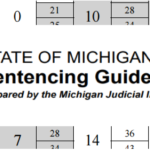How do you get a variance below sentencing guidelines?
A judge can sentence a defendant below the sentencing guidelines. How do you get them to do it? A lawyer must carefully craft a highly persuasive, credible, and compelling argument for a downward variance.

Judges Can Sentence Above or Below the Guidelines
The United States Supreme Court ruling that the United States Sentencing Guidelines (USSG) are unconstitutional has opened the door for judges to use their discretion to hand out sentences meaningfully tailored to weigh the defendant’s individual circumstances with the interests of society and justice. Judges still use the guidelines, but they are no longer mandatory. In the past, a sentencing judge could deviate below the guidelines under extraordinary circumstances. Today, judges can more freely find that a variance below sentencing guidelines is justified. The 2017 SCOTUS case of Beckles v. United States will likely significantly impact how judges impose sentences going forward.
The Supreme Court ruled that part of the sentencing guidelines, called the “Residual Clause,” is sufficiently defined to be constitutionally valid. In making this ruling, the court pointed out that some vagueness can be excused because the guidelines are not mandatory. The Residual Clause is contained in a part of the guidelines frequently referred to as the career offender guideline. Under this provision, a guideline range for a defendant with certain prior convictions for “crimes of violence” would be arbitrarily increased to be at or near the maximum sentence authorized by law.
As federal criminal defense attorneys, the lawyers with LEWIS & DICKSTEIN, P.L.L.C., have a track record of routinely and successfully making arguments for sentence variances below the guidelines. By following the logic of the Beckles’ decision, increased support is given to arguments that a prior conviction should not trigger the Residual Clause.
What is a “variance”?
A variance below from the sentencing guidelines in federal sentencing refers to a decision by a judge to impose a sentence that is less than the range suggested by the Sentencing Guidelines. The Federal Sentencing Guidelines set out a uniform sentencing policy for individuals and organizations convicted of felonies and serious (Class A) misdemeanors in the United States federal courts system.
A variance might occur for various reasons, such as the judge finding unique circumstances in the case that the Sentencing Guidelines do not adequately address or the judge determining that applying the guideline sentence would be unfair or inappropriate for the specific situation. Factors that might lead to a variance include the defendant’s background, the nature and circumstances of the offense, and the need to avoid unwarranted sentence disparities among defendants with similar records who have been found guilty of similar conduct.
The concept of variance differs from a “departure,” which is a more formal mechanism for sentencing outside the guideline range based on specific criteria set forth in the Guidelines. While departures are generally limited to specific, enumerated circumstances, variances are not limited in this way and provide judges with greater discretion to tailor sentences based on the broader statutory factors outlined in 18 U.S.C. § 3553(a).
The Supreme Court’s decision in United States v. Booker, 543 U.S. 220 (2005), played a key role in allowing for variances below the sentencing guidelines and making the Federal Sentencing Guidelines advisory, rather than mandatory. This decision gave judges more discretion to impose sentences that deviate from the guidelines, provided they consider the guidelines and the factors in 18 U.S.C. § 3553(a).

Sufficient But Not Greater Than Necessary
An example of an argument that can be made at sentencing is that a sentence at or near the bottom of the standard guidelines is sufficient but not greater than necessary. The USSGs provide that a sentence imposed by a judge should be sufficient but not greater than necessary. The guidelines were designed to provide sentence ranges that consider a defendant’s likelihood of recidivism or reoffending. Because the Residual Clause does not consider any such data or factors, an argument can be made that the ordinary guidelines are a better measure of what sentence is sufficient but not greater than necessary. A judge can find that a variance below the Sentencing Guidelines is appropriate if the Residual Clause results in an unfairly high recommended sentencing range.
The Residual Clause requires that the prior offense contain an element of force. This is not as simple as it may seem, and given the holding in Beckles, the sentencing court should feel more empowered to reject a prior offense based on this requirement. The phrase physical force means that it must be violent or strong physical force capable of causing pain or injury. The force must be intentional. By closely examining the elements of the prior crime, a defense lawyer may be able to argue that the law does not fulfill this requirement.
To determine if a prior offense qualifies as a “crime of violence,” courts have routinely looked to see if the elements from the previous offense match the generic definition of an offense enumerated in the Residual Clause. A defense lawyer may find a discrepancy by examining what actions would be a crime under the original law and then comparing that to the generic definition. If there is a difference, the defense lawyer can argue that the prior should not trigger the Residual Clause.
How does a federal defense lawyer persuade a judge to grant a variance below the sentencing guidelines?
A skilled, experienced, and influential defense lawyer employs various strategies and techniques to persuade a judge to grant a variance sentence below the recommended sentencing guideline range of the United States Sentencing Guidelines. The goal is to present a compelling case that addresses the statutory factors the judge must consider under 18 U.S.C. § 3553(a), which include the nature and circumstances of the offense, the history and characteristics of the defendant, and the need for the sentence imposed to reflect the seriousness of the offense, promote respect for the law, provide just punishment, afford adequate deterrence, protect the public, and provide the defendant with needed educational or vocational training, medical care, or other correctional treatment. Here are some of the key strategies:
- Crafting a Compelling Narrative: Present a holistic and humanizing narrative of the defendant’s life, emphasizing factors that may have led to the criminal behavior and showing the person behind the crime. This includes detailing personal, family, and socioeconomic backgrounds, any mental health or substance abuse issues, and efforts at rehabilitation.
- Demonstrating Unique Circumstances: Argue that the defendant’s situation is unique and not adequately addressed by the guidelines. This might involve unusual circumstances regarding the offense or the defendant’s personal history, making a guideline sentence inappropriate or excessively punitive.
- Highlighting Positive Contributions and Rehabilitation: Showcase the defendant’s positive contributions to society, community service, employment history, and any efforts at rehabilitation or remorse shown after the offense. Evidence of personal growth or rehabilitation is particularly persuasive in arguing for leniency.
- Using Expert Testimonies and Reports: Employ expert witnesses or reports to support arguments about the defendant’s mental health, the effectiveness of rehabilitation programs, or other relevant factors. This can include psychologists, psychiatrists, social workers, or other professionals who can provide insights into the defendant’s character or condition.
- Comparative Sentencing Arguments: Reference sentences in similar cases to argue for consistency and fairness. Highlighting disparities in sentencing for similar offenses can be a powerful argument for a variance.
- Legal Arguments and Precedent: Craft legal arguments that leverage relevant case law, statutory interpretations, and legal precedents that support a variance. This can include arguing that a variance is necessary to achieve the objectives of sentencing outlined in § 3553(a).
- Emphasizing Cooperation and Acceptance of Responsibility: If applicable, emphasize the defendant’s cooperation with law enforcement, acceptance of responsibility, and expressions of remorse. These factors can significantly impact the judge’s perception of the defendant and the appropriateness of a reduced sentence.
- Building a Relationship with the Court: Skilled lawyers know the importance of professionalism and credibility in the courtroom. Establishing a reputation for integrity, preparedness, and respect for the court can make a lawyer’s arguments more persuasive.
- Written Submissions and Oral Arguments: Prepare thorough and compelling written submissions, including sentencing memos that detail the arguments for a variance, and follow up with persuasive oral arguments during the sentencing hearing. The combination of written and oral advocacy is critical to persuading the court.
- Engaging with Probation Reports and Recommendations: Work with probation officers during the pre-sentence investigation to ensure that the pre-sentence report (PSR) accurately reflects factors favorable to the defendant. A favorable PSR can significantly influence a judge’s sentencing decision.
Persuading a judge to grant a variance sentence below the sentencing guideline’s recommended range involves a combination of legal acumen, thorough preparation, persuasive storytelling, and strategic advocacy that addresses the statutory sentencing factors and the specificities of the defendant’s case. You can expect This type of representation from LEWIS & DICKSTEIN, P.L.L.C.

Complicated? Yes. Are there lawyers who routinely persuade judges to order lenient sentences? Yes.
Does all of this sound complicated? If you think it does, you’re right. Most criminal defense lawyers struggle to understand these complex laws and have difficulty persuasively arguing for sentences below the sentencing guidelines. So why should you consult with LEWIS & DICKSTEIN, P.L.L.C. With decades of practicing criminal defense, we have developed an in-depth knowledge of the law that makes us highly effective when advocating for a reduced sentence. If you are charged with a felony and want a lawyer who gives you the best chance of getting a variance below the guidelines at sentencing, you should call LEWIS & DICKSTEIN, P.L.L.C. for a free consultation. We will take the time to talk with you, answer your questions, and address your concerns. Our lawyers will leave no stone unturned when devising a strategy to persuade a judge to order a sentence below the guidelines.
Call us today at (248) 263-6800 for a free consultation or complete an online Request for Assistance Form. We will contact you promptly and find a way to help you.












